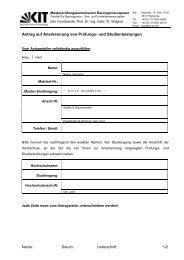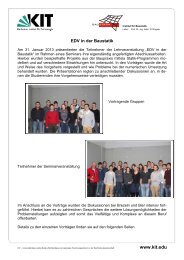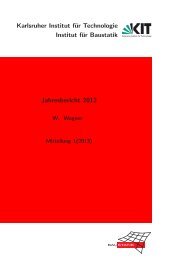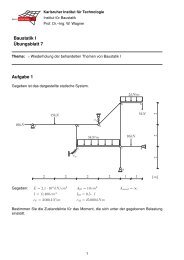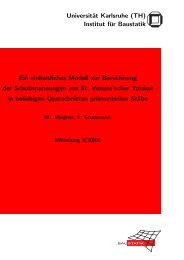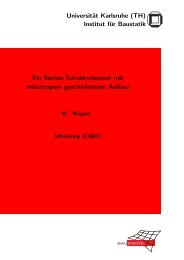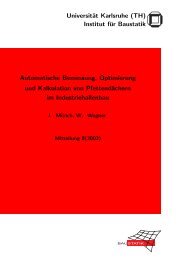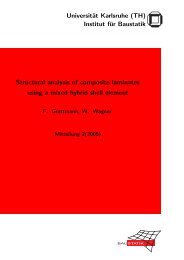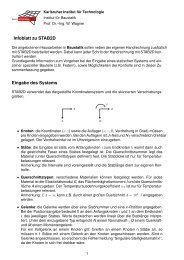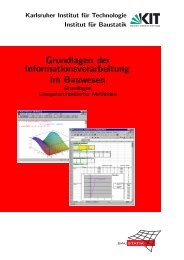Universität Karlsruhe (TH) - am Institut für Baustatik
Universität Karlsruhe (TH) - am Institut für Baustatik
Universität Karlsruhe (TH) - am Institut für Baustatik
You also want an ePaper? Increase the reach of your titles
YUMPU automatically turns print PDFs into web optimized ePapers that Google loves.
with membrane strains ε αβ , curvatures κ αβ and shear strains γ α . The second order curvatures<br />
ρ αβ are neglected for thin structures. We organize the shell strains in a vector<br />
ε G =[ε 11 ,ε 22 , 2ε 12 ,κ 11 ,κ 22 , 2κ 12 ,γ 1 ,γ 2 ] T , (6)<br />
where the subscript G refers to the Green–Lagrangean strain tensor (3). The work conjugate<br />
stress resultants are integrals of the Second Piola–Kirchhoff stress tensor and read<br />
σ =[n 11 ,n 22 ,n 12 ,m 11 ,m 22 ,m 12 ,q 1 ,q 2 ] T (7)<br />
with membrane forces n αβ = n βα , bending moments m αβ = m βα and shear forces q α .<br />
The shell is loaded statically by surface loads ¯p on Ω and by boundary loads ¯t on the boundary<br />
Γ σ . Hence the basic Hu–Washizu functional is formulated in matrix notation<br />
∫<br />
∫<br />
∫<br />
Π(v, σ, ε) = [W (ε)+σ T (ε G (v) − ε)] dA − u T ¯p dA − u T ¯t ds → stat. (8)<br />
(Ω)<br />
with the area element of the shell dA = jdξ 1 dξ 2 . Here, v =[u, ω] T , ε, andσ denote the<br />
independent displacement, strain and stress fields, with u = x − X the displacement vector<br />
and ω the vector of rotational par<strong>am</strong>eters of the shell middle surface. The strain energy W<br />
may be an arbitrary function of the independent strains. Introducing θ := [v, σ, ε] T and<br />
δθ := [δv,δσ,δε] T the stationary condition reads<br />
∫<br />
δΠ := g(θ,δθ) = [δε T (∂εW − σ)+δσ T (ε G − ε)+δε T Gσ] dA<br />
(Ω) ∫<br />
∫<br />
(9)<br />
− δu T ¯p dA − δu T ¯t ds =0<br />
(Ω)<br />
with the virtual shell strains δε G =[δε 11 ,δε 22 , 2δε 12 ,δκ 11 ,δκ 22 , 2δκ 12 ,δγ 1 ,δγ 2 ] T<br />
(Ω)<br />
(Γ σ)<br />
δε αβ = 1 2 (δx, α ·x, β +δx, β ·x, α )<br />
(Γ σ)<br />
δκ αβ = 1 2 (δx, α ·d, β +δx, β ·d, α +δd, α ·x, β +δd, β ·x, α )<br />
(10)<br />
δγ α = δx, α · d + δd · x, α .<br />
With integration by parts and applying standard arguments of variational calculus one obtains<br />
the associated Euler–Lagrange equations<br />
1<br />
(j ⎫<br />
j nα ), α +¯p = 0 ε G − ε = 0 ⎬<br />
1<br />
(j in Ω (11)<br />
j mα ), α +x, α ×n α = 0 ∂εW − σ = 0 ⎭<br />
with n α := n αβ x, β +q α d + m αβ d, β and m α := d × m αβ x, β , where the summation convention<br />
for repeated indices is used. The principle yields the static field equations with local form<br />
of linear and angular momentum, the geometric field equations and the constitutive law.<br />
Furthermore the static boundary conditions t − ¯t = 0 on Γ σ with t the boundary forces<br />
related to n α follow. The geometric boundary conditions u − ū = 0 on Γ u have to be fulfilled<br />
as constraints.<br />
5




